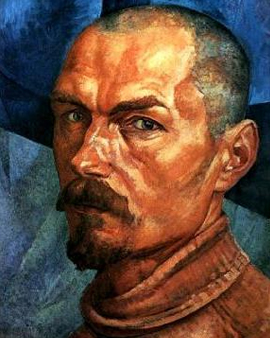The painter Kuzma Sergeevich Petrov-Vodkin is considered one of the most important Russian artists of the early 20th century. His early work was strongly influenced by the then popular style of the Symbolists. A strong influence of Art Nouveau can also be seen in Petrov-Vodkin's first works. During the 1910s, after carefully studying Italian painting of the early Renaissance, he developed his typical post-academic style of painting. The Russian artist also had a great interest in the genre of icon painting, which was particularly popular in his homeland and was especially popular with religious people. Petrov-Vodkin also drew inspiration from the progressive French post-impressionism of the artists Paul Gauguin and Henri Matisse.
Kuzma Sergeevich Petrov-Vodkin himself was the son of the simple shoemaker. Petrov-Vodkin enjoyed his basic artistic training as an assistant in the workshop of a painter before he completed a three-year study of fine arts in the city of Samara. The ambitious painter continued his education at the Central School for Technical Drawing of Baron Alexander Stieglitz in St. Petersburg.
In 1901 the inquisitive young man travelled to Europe. He made stops in Warsaw, Prague, Leipzig and Munich, among others. One year later he received his first award: the aspiring young artist was awarded a gold medal for the painting entitled "Family Cobbler". In the same year Petrov-Vodkin and the artists Kuznetsov and Utkin were given the opportunity to design the decoration of the Church of Our Lady of Kazan in the city of Saratov. The religious Petrov-Vodkin also created several paintings for the Church of St. Basil Zlatoverkh-Ovruch, the Naval Cathedral in Kronstadt, the Russian Church in the Italian city of Bari, and the Trinity Cathedral in the city of Sumy.
From 1905 to 1908 the talented painter went on a journey again. This time he went to the big city of London and to Italy. He also often stayed in France, where he visited friends and took lessons at the school of R. Kolarossi.
Back in Russia he lived from 1908 in St. Petersburg. One year later a Russian magazine printed works by Petrov-Vodkin for the first time. In the magazine "Apollo" readers could admire his painting sketches and drawings, which were created in Africa, Paris and in the Pyrenees.
Petrov-Vodkin was a member of a group of artists who held several group exhibitions in major Russian cities. Among others, his paintings "The Red Horse" and "Mother" were shown there. Both works enjoyed great popularity with both the public and the press. The successful painter also took part in other exhibitions of the so-called Union of Russian Artists. As a secondary income he taught painting at the school of Elizabeth Zvantseva.
The professional success of the talented Russian grew steadily. His solo exhibitions in 1936 in the State Russian Museum in Leningrad and one year later in Moscow both received excellent reviews.
×





.jpg)
.jpg)
.jpg)
.jpg)
.jpg)
.jpg)
.jpg)
.jpg)
 1934 - (MeisterDrucke-157194).jpg)
 1934 - (MeisterDrucke-157194).jpg)
.jpg)
.jpg)
.jpg)
.jpg)
.jpg)
.jpg)
.jpg)
.jpg)
_P_-_(MeisterDrucke-1318800).jpg)
_P_-_(MeisterDrucke-1318800).jpg)
_1922_-_(MeisterDrucke-317546).jpg)
_1922_-_(MeisterDrucke-317546).jpg)
.jpg)
.jpg)
.jpg)
.jpg)
.jpg)
.jpg)
.jpg)
.jpg)
.jpg)
.jpg)
.jpg)
.jpg)
_-_(MeisterDrucke-1325078).jpg)
_-_(MeisterDrucke-1325078).jpg)
.jpg)
.jpg)
_Peinture_de_Kuzma_S_-_(MeisterDrucke-1320733).jpg)
_Peinture_de_Kuzma_S_-_(MeisterDrucke-1320733).jpg)
.jpg)
.jpg)
.jpg)
.jpg)
.jpg)
.jpg)
.jpg)
.jpg)
_-_(MeisterDrucke-1325920).jpg)
_-_(MeisterDrucke-1325920).jpg)
.jpg)
.jpg)
_(Kouzma_Petro_-_(MeisterDrucke-1320799).jpg)
_(Kouzma_Petro_-_(MeisterDrucke-1320799).jpg)
.jpg)
.jpg)
.jpg)
.jpg)
_Peinture_-_(MeisterDrucke-1313386).jpg)
_Peinture_-_(MeisterDrucke-1313386).jpg)
.jpg)
.jpg)
.jpg)
.jpg)
_(1889-1966)_Peinture_de_Kuzma_-_(MeisterDrucke-1325913).jpg)
_(1889-1966)_Peinture_de_Kuzma_-_(MeisterDrucke-1325913).jpg)
_Peinture_de_Kuzma_Sergeyevich_-_(MeisterDrucke-1313632).jpg)
_Peinture_de_Kuzma_Sergeyevich_-_(MeisterDrucke-1313632).jpg)
_-_(MeisterDrucke-192481).jpg)
_-_(MeisterDrucke-192481).jpg)
_(Kouzma_Pe_-_(MeisterDrucke-1321097).jpg)
_(Kouzma_Pe_-_(MeisterDrucke-1321097).jpg)
.jpg)
.jpg)
.jpg)
.jpg)
.jpg)
.jpg)
_Algerie_(Casbah_Algeria)_-_Peinture_de_Kuzma_Sergeyevich_Petr_-_(MeisterDrucke-1325898).jpg)
_Algerie_(Casbah_Algeria)_-_Peinture_de_Kuzma_Sergeyevich_Petr_-_(MeisterDrucke-1325898).jpg)
_(Kouzma_-_(MeisterDrucke-1320798).jpg)
_(Kouzma_-_(MeisterDrucke-1320798).jpg)
.jpg)
.jpg)
.jpg)
.jpg)
_Peinture_de_Kuzma_Sergeyevich_Petrov_Vo_-_(MeisterDrucke-1325941).jpg)
_Peinture_de_Kuzma_Sergeyevich_Petrov_Vo_-_(MeisterDrucke-1325941).jpg)
_Peinture_de_Kuzm_-_(MeisterDrucke-1318503).jpg)
_Peinture_de_Kuzm_-_(MeisterDrucke-1318503).jpg)
_(Kouzma_Pe_-_(MeisterDrucke-1318537).jpg)
_(Kouzma_Pe_-_(MeisterDrucke-1318537).jpg)
.jpg)
.jpg)
.jpg)
.jpg)
.jpg)
.jpg)
_-_(MeisterDrucke-1323244).jpg)
_-_(MeisterDrucke-1323244).jpg)
_Kuzma_Sergeyevich_(1878-1939)_-_-_(MeisterDrucke-939225).jpg)
_Kuzma_Sergeyevich_(1878-1939)_-_-_(MeisterDrucke-939225).jpg)
.jpg)
.jpg)
.jpg)
.jpg)
.jpg)
.jpg)
.jpg)
.jpg)
.jpg)
.jpg)
 Brothers Karamazov 19 - (MeisterDrucke-572732).jpg)
 Brothers Karamazov 19 - (MeisterDrucke-572732).jpg)
.jpg)
.jpg)
.jpg)
.jpg)
.jpg)
.jpg)
.jpg)
.jpg)
.jpg)
.jpg)
_(K_-_(MeisterDrucke-1314227).jpg)
_(K_-_(MeisterDrucke-1314227).jpg)
.jpg)
.jpg)
.jpg)
.jpg)
.jpg)
.jpg)
.jpg)
.jpg)
.jpg)
.jpg)
.jpg)
.jpg)
_(Kouzma_-_(MeisterDrucke-1325921).jpg)
_(Kouzma_-_(MeisterDrucke-1325921).jpg)
.jpg)
.jpg)
_Peinture_de_Kuzma_Sergeyevich_Petrov_Vodkin_(P_-_(MeisterDrucke-1318506).jpg)
_Peinture_de_Kuzma_Sergeyevich_Petrov_Vodkin_(P_-_(MeisterDrucke-1318506).jpg)
.jpg)
.jpg)
.jpg)
.jpg)
.jpg)
.jpg)
.jpg)
.jpg)
_(K_-_(MeisterDrucke-1322990).jpg)
_(K_-_(MeisterDrucke-1322990).jpg)
_(Kouzma_Petr_-_(MeisterDrucke-1313914).jpg)
_(Kouzma_Petr_-_(MeisterDrucke-1313914).jpg)
_Peinture_de_Kuzma_Sergeyevic_-_(MeisterDrucke-1325922).jpg)
_Peinture_de_Kuzma_Sergeyevic_-_(MeisterDrucke-1325922).jpg)
_Peinture_de_Kuzma_Sergeyevich_Petrov_Vodk_-_(MeisterDrucke-1322923).jpg)
_Peinture_de_Kuzma_Sergeyevich_Petrov_Vodk_-_(MeisterDrucke-1322923).jpg)
.jpg)
.jpg)
_(Kouzma_Pe_-_(MeisterDrucke-1322701).jpg)
_(Kouzma_Pe_-_(MeisterDrucke-1322701).jpg)
_(Kou_-_(MeisterDrucke-1322719).jpg)
_(Kou_-_(MeisterDrucke-1322719).jpg)
.jpg)
.jpg)
_Peinture_de_Kuzma_Sergeyevich_Petrov_Vodkin_(Pet_-_(MeisterDrucke-1323227).jpg)
_Peinture_de_Kuzma_Sergeyevich_Petrov_Vodkin_(Pet_-_(MeisterDrucke-1323227).jpg)
.jpg)
.jpg)
.jpg)
.jpg)
.jpg)
.jpg)
.jpg)
.jpg)






